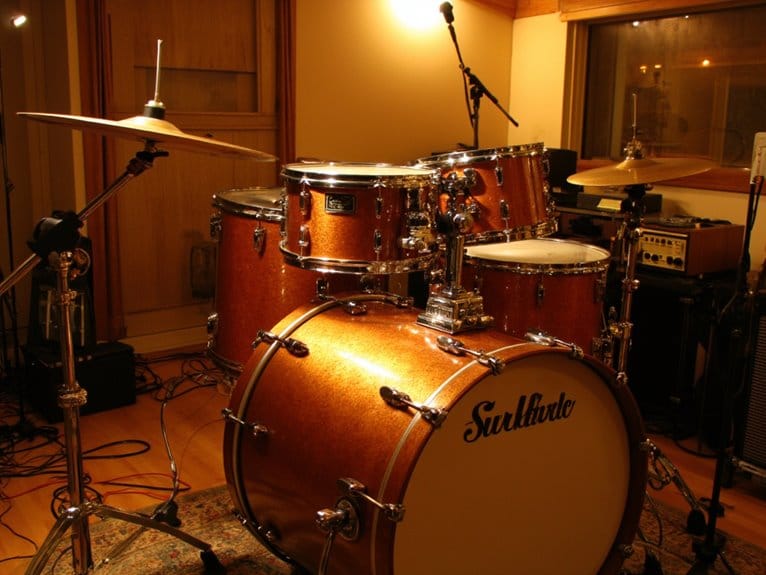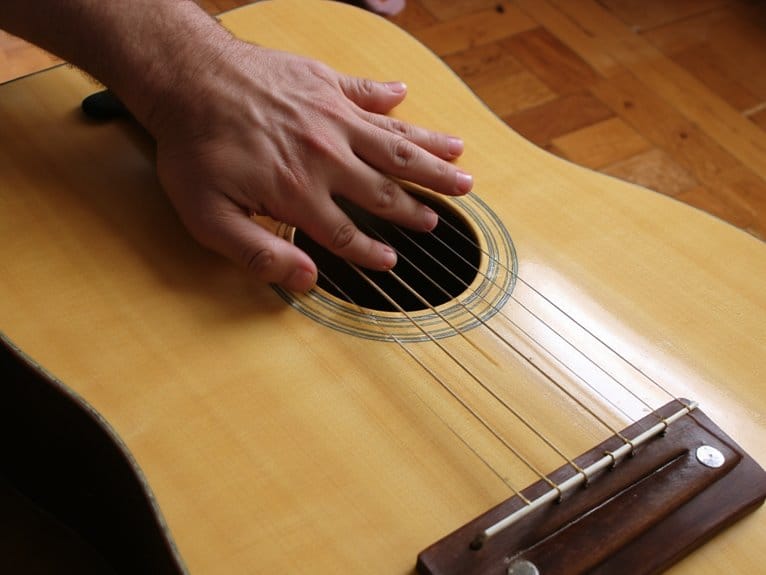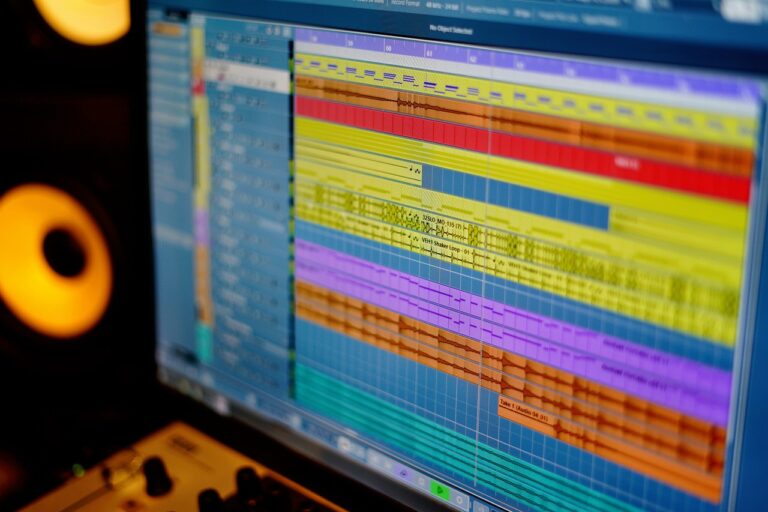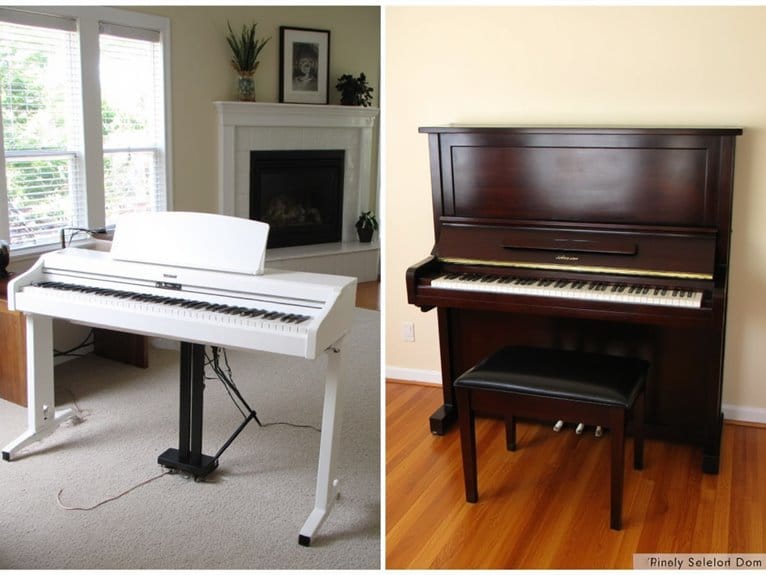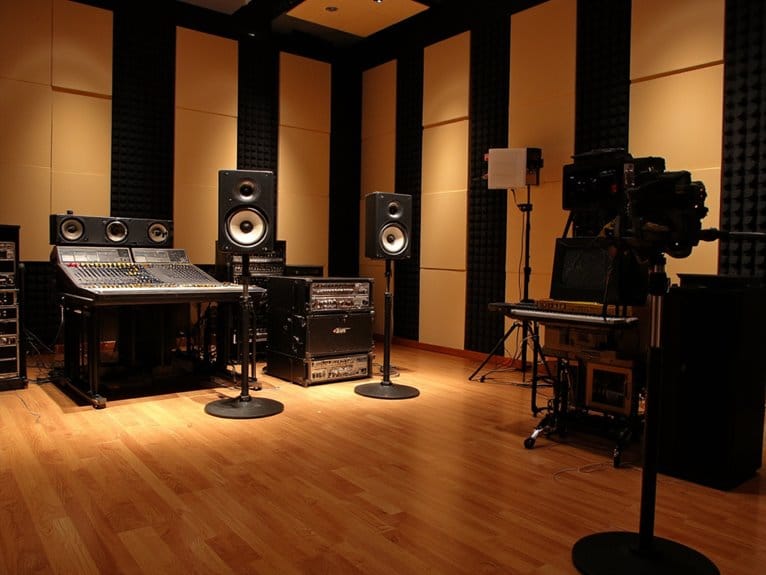The Glyn Johns Method: Natural Drum Sounds
The Glyn Johns method transforms your drum recordings with just four strategically placed microphones, creating spacious, natural sounds that capture the room’s character. You’ll position two overhead condensers-one 40-60 inches above the snare, another six inches above the floor tom-ensuring they’re equidistant from the snare for phase coherence. Add a dynamic mic inside the kick drum and another above the snare rim, and you’ll achieve that coveted vintage ambience across rock, folk, and punk genres that deeper exploration reveals.
We are supported by our audience. When you purchase through links on our site, we may earn an affiliate commission, at no extra cost for you. Learn more.
Notable Insights
- Uses only four microphones: two overheads, one kick drum mic, and one snare mic for spacious, natural drum sounds.
- All microphones must be equidistant from the snare drum to maintain phase coherence and prevent cancellation issues.
- Main overhead positioned 40-60 inches above snare, with second overhead 6 inches above floor tom for optimal integration.
- Works effectively across multiple genres including rock, pop, folk, and punk while maintaining organic, vintage character.
- Requires strong drumming performance and suitable acoustic environment to achieve the signature “in-the-room” drum feel.
Microphone Placement and Setup Fundamentals
Four carefully positioned microphones form the foundation of the legendary Glyn Johns drum recording technique, a method I’ve found creates remarkably spacious, natural-sounding drums that seem to breathe within the stereo field.
You’ll start with two overhead mics-one positioned 40 to 60 inches directly above the snare drum, the second about 6 inches above the floor tom, angled 90 degrees from the first. Both overheads must be equidistant from the snare’s center to maintain phase coherence, which I can’t stress enough.
Your third mic captures the kick drum, either inside the shell or near the port hole, while the fourth positions a couple inches above the snare rim. Cardioid patterns help reduce bleed between drums while maintaining the natural ambience this technique is known for.
The microphone types you choose-typically large-diaphragm condensers for overheads and dynamics for close mics-directly influence how your recording environment translates to tape. This approach allows for quicker setups compared to traditional multi-mic arrangements that often become time-consuming and overly complex.
Achieving Phase Coherence and Sonic Balance
How do you guarantee that four strategically placed microphones work together harmoniously instead of fighting each other acoustically? The secret lies in using your snare drum as the central reference point, positioning each microphone equidistant from it to eliminate timing differences that create phase challenges.
I’ve found that placing the main overhead 40-60 inches above the snare, while maintaining consistent distances to other mics, forms the foundation for proper sound integration.
You’ll want to monitor in stereo during setup, listening carefully for hollow or thin sounds that indicate phase cancellation.
Adjusting mic angles and heights incrementally helps mitigate issues in smaller rooms, while panning overheads hard left and right with centered snare and kick maintains natural stereo imaging without compromising the cohesive drum sound you’re after.
Applications Across Musical Genres and Recording Situations
Three decades of working with this technique have shown me that the Glyn Johns method adapts remarkably well across musical genres, from the thunderous presence it brought to John Bonham’s kit on Led Zeppelin recordings to the intimate, organic textures I’ve captured for indie folk sessions.
The genre versatility consistently surprises engineers who initially assume it’s only suited for classic rock:
Don’t let preconceptions limit your creativity-this classic technique delivers exceptional results far beyond its rock and roll origins.
- Vintage-inspired genres benefit from the punchy, ambient capture that defines rock, pop, and blues recordings.
- Indie and folk productions gain natural, organic drum tones that complement acoustic instruments beautifully.
- Punk and garage rock sessions embrace the minimalistic setup’s raw, unprocessed character.
- Live recording situations leverage the recording efficiency of three to four mics while maintaining professional quality.
You’ll find this approach particularly valuable when session time’s limited but you’re still aiming for that coveted “in-the-room” drum feel. The success of this method relies heavily on strong drumming paired with a suitable acoustic environment, making the drummer’s performance and room acoustics just as crucial as microphone placement.
On a final note
You’ll find the Glyn Johns method isn’t just another recording technique-it’s your gateway to capturing drums with remarkable depth and authenticity. I’ve watched countless engineers struggle with overcomplicating their setups, but this approach strips away the unnecessary complexity. When you’re positioning those overhead mics at equal distances, measuring carefully with your tape, you’re creating space that lets the kit breathe naturally while maintaining that essential phase relationship.

